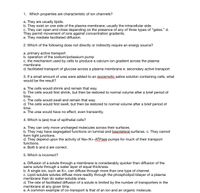
Biochemistry
9th Edition
ISBN: 9781319114671
Author: Lubert Stryer, Jeremy M. Berg, John L. Tymoczko, Gregory J. Gatto Jr.
Publisher: W. H. Freeman
expand_more
expand_more
format_list_bulleted
Question
Answer 2-5

Transcribed Image Text:1. Which properties are characteristic of ion channels?
a. They are usually lipids.
b. They exist on one side of the plasma membrane, usually the intracellular side.
c. They can open and close depending on the presence of any of three types of "gates." d.
They permit movement of ions against concentration gradients.
e. They mediate facilitated diffusion.
2. Which of the following does not directly or indirectly require an energy source?
a. primary active transport
b. operation of the sodium/potassium pump
c. the mechanism used by cells to produce a calcium ion gradient across the plasma
membrane
d. facilitated transport of glucose across a plasma membrane e. secondary active transport
3. If a small amount of urea were added to an įsoosmotic saline solution containing cells, what
would be the result?
a. The cells would shrink and remain that way.
b. The cells would first shrink, but then be restored to normal volume after a brief period of
time.
c. The cells would swell and remain that way.
d. The cells would first swell, but then be restored to normal volume after a brief period of
time.
e. The urea would have no effect, even transiently.
4. Which is (are) true of epithelial cells?
a. They can only move uncharged molecules across their surfaces.
b. They may have segregated functions on luminal and basolateral surfaces. c. They cannot
form tight junctions.
d. They depend upon the activity of Na+/K+-ATPase pumps for much of their transport
functions.
e. Both b and d are correct.
5. Which is incorrect?
a. Diffusion of a solute through a membrane is considerably quicker than diffusion of the
same solute through a water layer of equal thickness.
b. A single ion, such as K+, can diffuse through more than one type of channel.
c. Lipid-soluble solutes diffuse more readily through the phospholipid bilayer of a plasma
membrane than do water-soluble ones.
d. The rate of facilitated diffusion of a solute is limited by the number of transporters in the
membrane at any given time.
e. A common example of co-transport is that of an ion and an organic molecule.
Expert Solution
This question has been solved!
Explore an expertly crafted, step-by-step solution for a thorough understanding of key concepts.
This is a popular solution
Trending nowThis is a popular solution!
Step by stepSolved in 3 steps

Knowledge Booster
Similar questions
arrow_back_ios
arrow_forward_ios
Recommended textbooks for you
 BiochemistryBiochemistryISBN:9781319114671Author:Lubert Stryer, Jeremy M. Berg, John L. Tymoczko, Gregory J. Gatto Jr.Publisher:W. H. Freeman
BiochemistryBiochemistryISBN:9781319114671Author:Lubert Stryer, Jeremy M. Berg, John L. Tymoczko, Gregory J. Gatto Jr.Publisher:W. H. Freeman Lehninger Principles of BiochemistryBiochemistryISBN:9781464126116Author:David L. Nelson, Michael M. CoxPublisher:W. H. Freeman
Lehninger Principles of BiochemistryBiochemistryISBN:9781464126116Author:David L. Nelson, Michael M. CoxPublisher:W. H. Freeman Fundamentals of Biochemistry: Life at the Molecul...BiochemistryISBN:9781118918401Author:Donald Voet, Judith G. Voet, Charlotte W. PrattPublisher:WILEY
Fundamentals of Biochemistry: Life at the Molecul...BiochemistryISBN:9781118918401Author:Donald Voet, Judith G. Voet, Charlotte W. PrattPublisher:WILEY BiochemistryBiochemistryISBN:9781305961135Author:Mary K. Campbell, Shawn O. Farrell, Owen M. McDougalPublisher:Cengage Learning
BiochemistryBiochemistryISBN:9781305961135Author:Mary K. Campbell, Shawn O. Farrell, Owen M. McDougalPublisher:Cengage Learning BiochemistryBiochemistryISBN:9781305577206Author:Reginald H. Garrett, Charles M. GrishamPublisher:Cengage Learning
BiochemistryBiochemistryISBN:9781305577206Author:Reginald H. Garrett, Charles M. GrishamPublisher:Cengage Learning Fundamentals of General, Organic, and Biological ...BiochemistryISBN:9780134015187Author:John E. McMurry, David S. Ballantine, Carl A. Hoeger, Virginia E. PetersonPublisher:PEARSON
Fundamentals of General, Organic, and Biological ...BiochemistryISBN:9780134015187Author:John E. McMurry, David S. Ballantine, Carl A. Hoeger, Virginia E. PetersonPublisher:PEARSON

Biochemistry
Biochemistry
ISBN:9781319114671
Author:Lubert Stryer, Jeremy M. Berg, John L. Tymoczko, Gregory J. Gatto Jr.
Publisher:W. H. Freeman

Lehninger Principles of Biochemistry
Biochemistry
ISBN:9781464126116
Author:David L. Nelson, Michael M. Cox
Publisher:W. H. Freeman

Fundamentals of Biochemistry: Life at the Molecul...
Biochemistry
ISBN:9781118918401
Author:Donald Voet, Judith G. Voet, Charlotte W. Pratt
Publisher:WILEY

Biochemistry
Biochemistry
ISBN:9781305961135
Author:Mary K. Campbell, Shawn O. Farrell, Owen M. McDougal
Publisher:Cengage Learning

Biochemistry
Biochemistry
ISBN:9781305577206
Author:Reginald H. Garrett, Charles M. Grisham
Publisher:Cengage Learning

Fundamentals of General, Organic, and Biological ...
Biochemistry
ISBN:9780134015187
Author:John E. McMurry, David S. Ballantine, Carl A. Hoeger, Virginia E. Peterson
Publisher:PEARSON